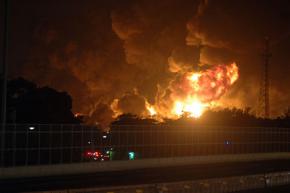Real victims of a refinery fire
, a member of the Organización Socialista Internacional, reports on the consequences of a refinery fire that filled the sky over San Juan with smoke.
THE GOVERNMENT in Puerto Rico is exploiting an explosion and fire at an oil refinery on the outskirts of the capital of San Juan to whip up fears of “terrorism” and crack down on opponents, including unions.
The Caribbean Petroleum refinery in Cataño burst into flames in the early morning hours of October 23. At least 1,000 people were evacuated from their homes as firefighters battled to put out the blaze for the next three days.
U.S. government agencies, including the Environmental Protection Agency, the Coast Guard, the Federal Emergency Management Agency and the FBI, are involved with Puerto Rican authorities in investigating the fire.
But officials immediately suggested that “terrorists” could have played a role in the tragedy. Even before any investigation had started, the FBI director in Puerto Rico, Luis Fraticelli, had raised the threat of terrorism, and the media in Puerto Rico jumped to the conclusion that unions were somehow involved.
Similar accusations were leveled against workers and their unions after a fire at the Carribbean Petroleum facility in Palo Seco, during the governorship of Aníbal Acevedo Vilá. Shortly before the fire, the union had announced it could strike over grievances. But officials later had to recognize that lack of supervision and maintenance of facilities—which workers had been pointing out for a long time before—at the Palo Seco facility was to blame for the fire. Likewise, in the case of the Cataño fire, Caribbean Petroleum management ignored workers’ warnings describing a “strange smell” in the area.

THE REAL tragedy is the way this refinery fire will hit the working class in Puerto Rico. The Puerto Rican government has ignored poor communities, allowing the construction of factories, solid waste processing facilities, fuel storage facilities, petrochemical plants, airports, meat production facilities and other factories in areas where workers live.
Some of the best-known problems have been at a CORCO petroleum refinery established in 1956 on the southern part of the island. A number of people have died due to fires in the plant, and others have fallen victim to cancer and other illnesses thought to be linked to the refinery. Many people remember how a fertile valley was turned into a wasteland and how surrounding beaches became so polluted that people couldn’t swim off them.
In 1996, an explosion along a natural gas line in Río Piedras, a very populated part of San Juan, killed 33 people and injured dozens more. The San Juan Gas Company ignored workers’ warning about a leak in the gas pipes.
There are many other cases of pollution and dangerous conditions caused by corporations and U.S. government facilities in Puerto Rico, including the pharmaceutical company Upjohn, waste disposal facilities in Barceloneta and Juncos, and U.S. military’s weapons testing and training range in Vieques, among others.
But poor communities have also resisted construction of dangerous facilities near their homes. For example, one working class community on the southern side of the island blocked the construction of a natural gas pipe that was a joint effort between the government and the international construction company Skanska. The community won the battle by blocking access to machinery used in the construction site.
There are 14 Superfund sites in Puerto Rico, according to a federal government report. They are all close to poor communities or important water resources.
The main concern of the Puerto Rican government after the explosions at Caribbean Petroleum facility was to save private property and keep the costs low for helping people affected by the fire. It doesn’t care about health and safety of the community since it allowed the construction of the fuel storage facility near poor areas like Puente Blanco, Levittown and Barrio Amelia.
Ironically, the government announced the layoff of firefighters, nurses and social workers a couple weeks before the explosion. The same people who worked to extinguish the fire and to help people affected by it might be unemployed after November 6. What is going to happen if there is a disaster after that date?
While the government cuts services to justify privatization and meets with investors to discuss Public-Private Alliances, a private company causes a disaster that will cost millions of dollars for the government. But the government’s policy is to save the company and accuse the opposition of “terrorism.”
We know who the true terrorists are—the companies that pollute in spite of the health consequences for the population, and a government that allows polluters to build dangerous facilities near populated areas.
The working class should not have to pay such a high price for a place to live. The Caribbean Petroleum Company should pay the cost of this disaster—and the rich should pay for the environmental and health crises they create.


